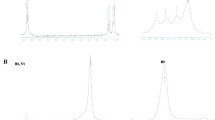Abstract
Poly(3-hydroxybutyrate-co-3-hydroxyvalerate), poly(3HB-co-3HV), copolyesters, with 3-hydroxyvalerate (3HV) contents ranging from 17 to 60 mol%, were produced byAlcaligenes sp. MT-16, and their biocompatibility evaluated by the growth of Chinese hamster ovary (CHO) cells and the adsorption of blood proteins and platelets onto their film surfaces. The number of CHO cells that adhered to and grew on these films was higher with increasing 3HV content. In contrast, the tendency for blood proteins and platelets to adhere to the copolyester surfaces significantly decreased with increasing 3HV content. Examination of the surface morphology using atomic force microscopy revealed that the surface roughness was an important factor in determining the biocompatibility of theses copolyesters. The results obtained in this study suggest that poly(3HB-co-3HV) copolyesters, with >30 mol% 3HV, may be useful in biocompatible biomedical applications.
Similar content being viewed by others
References
Steinbüchel, A. and T. Lutke-Eversloh (2003) Metabolic engineering and pathway construction for biotechnological production of relevant polyhydroxyalkanoates in microorganisms.Biochem. Eng. J. 16: 81–96.
Zinn, M., B. Witholt, and T. Egli (2001) Occurrence, synthesis, and medical application of bacterial polyhydroxyalkanoate.Adv. Drug. Deliv. Rev. 53: 5–21.
Williams, S. F., D. P. Martin, D. M. Horowitz, and O. P. Peoples (1999) PHA applications: addressing the price issue: 1. Tissue engineering.Int. J. Biol. Macromol. 25: 111–121.
Feng, L., N. Yoshie, N. Asakawa, and Y. Inoue (2004) Comonomer-unit compositions, physical properties and biodegradability of bacterial copolyhydroxyalkanoates.Macromol. Biosci. 4: 186–198.
Doi, Y. (1990) Microbial polyester. VCH pulicher, Inc., New York, NY, USA.
Ramsay, B. A., K. Lomaliza, C. Chavarie, B. Dube, P. Bataille, and J. A. Ramsay (1990) Production of poly-(β-hydroxybutyric-co-β-hydroxyvaleric) acid.Appl. Environ. Microbiol. 56: 2095–2098.
Reusch, R. N. (1995) Low molecular weight complexed poly(3-hydroxybutyrate): a dynamic and versatile moleculein vivo.Can. J. Microbiol. 41 Suppl: 50–54.
Tezcaner, A., K. Bugra, and V. Hasirci (2003) Retinal pigment epithelium cell culture on surface modified poly(hydroxybutyrate-co-hydroxyvalerate) thin films.Biomaterials 24: 4573–4583.
Gogolewski, S., M. Jovanovic, S. M. Perren, J. G. Dillon, and M. K. Hughes (1993) Tissue response andin vivo degradation of selected polyhydroxyacids: polylactides (PLA), poly(3-hydroxybutyrate) (PHB), and poly(3-hydroxybutyrate-co-3-hydroxyvalerate) (PHB/VA).J. Biomed. Mater. Res. 27: 1135–1148.
Rouxhet, L., F. Duhoux, O. Borecky, R. Legras, and Y. J. Schneider (1998) Adsorption of albumin, collagen, and fibronection on the surface of poly(hydroxybutyrate-hydroxyvalerate) (PHB/HV) and of poly (epsilon-caprolactone) (PCL) films modified by an alkaline hydrolysis and of poly (ethylene terephtalate) (PET) track-etched membranes.J. Biomater. Sci. Polym. Edn. 9: 1279–1304.
Choi, G. G., M. W. Kim, J. Y. Kim, and Y. H. Rhee (2003) Production of poly(3-hydroxybutyrate-co-3-hydroxyvalerate) with high molar fractions of 3-hydroxyvalerate by a threonine-overproducing mutant ofAlcaligenes sp. SH-69.Biotechnol. Lett. 25: 665–670.
Choi, G. G., H. W. Kim, and Y. H. Rhee (2004) Enzymatic and non-enzymatic degradation of poly(3-hydroxybutyrate-co-3-hydroxyvalerate) copolyesters produced byAlcaligenes sp. MT-16.J. Microbiol. 42: 346–352.
Chung, S. H., G. G. Choi, H. W. KIm, and Y. H. Rhee (2001) Effect of levulinic acid on the production of poly(3-hydroxybutyrate-co-3-hydroxyvalerate) byRalstonia eutropha KHB-8862.J. Microbiol. 39: 79–82.
Kim, Y. B., D. Y. Kim, and Y. H. Rhee (1999) PHAs produced byPseudomonas putida andPseudomonas oleovorans grown withn-alkanoic acids containing aromatic groups.Macromolecules 32: 6058–6064.
Choi, J. I. and S. Y. Lee (2004) High level production of supra molecular weight poly(3-hydroxybutyrate) by metabolically engineeredEscherichia coli.Biotechnol. Bioprocess Eng. 9: 196–200.
Kang, H. O., C. W. Chung, H. W. Kim, Y. B. Kim, and Y. H. Rhee (2001) Cometabolic biosynthesis of copolyesters consisting of 3-hydroxyvalerate and medium-chain-length 3-hydroxyalkanoates byPseudomonas sp. DSY-82.Antonie Van Leeuwenhoek 80: 185–191.
Amiji, M. and K. Park (1993) Surface modification of polymeric biomaterials with poly(ethylene oxide), albumin, and heparin for reduced thrombogenicity.J. Biomater. Sci. Polym. Edn. 4: 217–234.
Kottke-Marchant, K., J. M. Anderson, Y. Umemura, and R. E. Marchant (1989) Effect of albumin coating on thein vitro blood compatibility of Dacron® arterial prostheses.Biomaterials 10: 147–155.
Hahn, S. K. and A. S. Hoffman (2004) Characterization of biocompatible polyelectrolyte complex multilayer of hyaluronic acid and poly-L-lysine.Biotechnol. Bioprocess Eng. 9: 179–183.
Hahn, S. K., R. Ohri, and C. M. Giachelli (2005) Anticalcification of bovine pericardium for bioprosthetic heart valves after surface modification with hyaluronic acid derivatives.Biotechnol. Bioprocess Eng. 10: 218–224.
Fujimoto, K., H. Inoue, and Y. Ikada (1993) Protein adsorption and platelet adhesion onto polyurethane grafted with methoxy-poly(ethylene glycol) methacrylate by plasma technique.J. Biomed. Mater. Res. 27: 1559–1567.
Chung, C. W., H. W. Kim, Y. B. Kim, and Y. H. Rhee (2003) Poly(ethylene glycol)-grafted poly(3-hydroxyundecenoate) networks for enhanced blood compatibility.Int. J. Biol. Macromol. 32: 17–22.
Lee, J. H., J. W. Lee, G. S. Khang, and H. B. Lee (1997) Interaction of cells on chargeable functional group gradient surfaces.Biomaterials 18: 351–358.
Zao, K., Y. Deng, and G. Q. Chen (2003) Effects of surface morphology on the biocompatibility of polyhydroxyalkanoates.Biochem. Eng. J. 16: 115–123.
Kim, S. S., H. W. Kim, S. H. Yuk, S. Y. Oh, P. K. Pak, and H. B. Lee (1995) Blood and cell compatibility of gelatincarrageenan mixtures cross-linked by glutaraldehyde.Biomaterials 17: 813–821.
Kim, Y. H., D. K. Han, K. D. Park, and S. H. Kim (2003) Enhanced blood compatibility of polymers grafted by sulfonated PEO via a negative cilia concept.Biomaterials 24: 2213–2223.
Kurano, N., C. Leist, F. Messi, S. Kurano, and A. Fiechter (1990) Growth behavior of Chinese hamster ovary cells in a compact loop bioreactor. 2. Effects of medium components and waste products.J. Biotechnol. 15: 113–128.
Washburn, N. R., K. M. Yamada, C. G. Simon, Jr., S. B. Kennedy, and E. J. Amis (2004) High-throughput investigation of osteoblast response to polymer crystallinity: Influence of nanometer-scale roughness on proliferation.Biomaterials 25: 1215–1224.
Author information
Authors and Affiliations
Corresponding author
Rights and permissions
About this article
Cite this article
Choi, G.G., Kim, H.W., Kim, Y.B. et al. Biocompatibility of poly(3-hydroxybutyrate-co-3-hydroxyvalerate) copolyesters produced byAlcaligenes sp. MT-16. Biotechnol. Bioprocess Eng. 10, 540–545 (2005). https://doi.org/10.1007/BF02932291
Received:
Accepted:
Issue Date:
DOI: https://doi.org/10.1007/BF02932291




